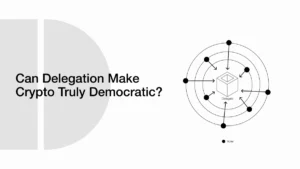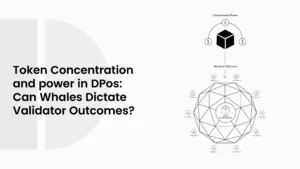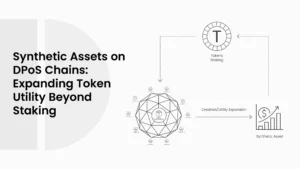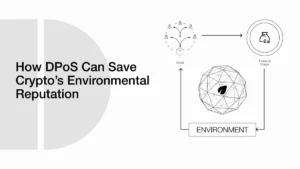DPoS as an Economic Laboratory: Incentives, Rewards, and Risks
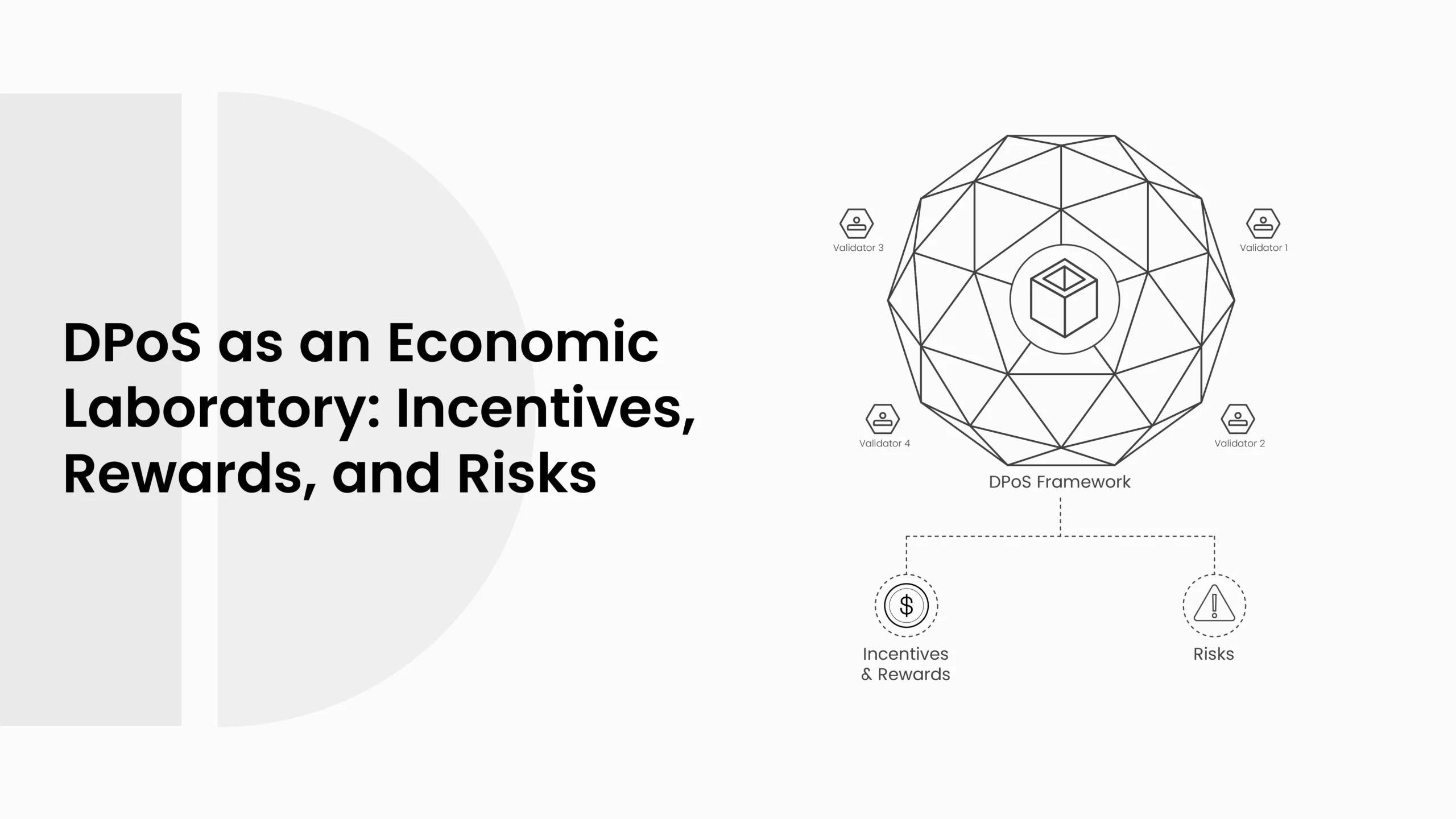
Delegated Proof of Stake, often called DPoS, is one of the most interesting systems in blockchain today. It is not just a way to confirm transactions. It is also like a small economy. In DPoS, people vote, people get rewards, and people also take risks. This makes it more than a technical process. It works like an experiment in economics.
- What is Delegated Proof of Stake (DPoS)?
- DPoS vs PoW and PoS
- Why Economists Look at DPoS
- Incentives in DPoS Systems
- How Incentives Shape Behavior
- Types of Incentives
- Incentive Structures Compared
- Rewards: Short-Term and Long-Term
- How Rewards Are Shared
- Short-Term Gains vs Long-Term Network Health
- Table 2: Rewards Distribution Models
- Why Rewards Matter for Trust
- Risks in Delegated Proof of Stake Governance
- Risk of Centralization
- Risk of Collusion and Vote Buying
- Risk of Free-Riding
- Common Risks in DPoS
- Why Risks Cannot Be Ignored
- DPoS as a Real-World Economic Model
- Links to Traditional Economic Systems
- Why DPoS is Like a Lab
- DPoS vs Real-World Systems
- Why This Comparison Matters
- Psychological and Economic Trust in DPoS
- The Role of Trust
- Types of Trust in DPoS
- Incentive Compatibility: Balancing Rewards and Risks
- What Incentive Compatibility Means
- How DPoS Tries to Stay Balanced
- Governance Risks and Free-Rider Problems
- The Free-Rider Issue
- Governance Weakness
- Why This Matters
- Economic Models Inside DPoS
- Why DPoS is Like a Mini-Economy
- Incentives as Currency
- Validator Stakes and Slashing Mechanisms
- Types of Stakes
- Slashing as a Penalty
- Stakes and Penalties in DPoS
- Effort and Work in Validation
- Human and Machine Effort
- Types of Effort
- Why Effort Balance Matters
- Validator Dominance
- What Validator Dominance Means
- Government and Law in DPoS
- Why External Rules Still Matter
- Internal Rule of Law
- Centralization Challenges
- The Myth of Decentralization
- Why Centralization Happens
- DPoS as an Ongoing Experiment
- Why It Is Called a Laboratory
- Lessons From Behavior
- Case Studies of DPoS Chains
- EOS
- TRON
- Steem
- Case Studies of DPoS Chains
- Conclusion: Incentives, Rewards, and Risks in DPoS
- Frequently Asked Questions About DPoS as an Economic Laboratory
- What is Delegated Proof of Stake (DPoS)?
- How do rewards work in DPoS?
- What is slashing in DPoS?
- Why do people call DPoS an economic laboratory?
- What are the risks of DPoS?
- Is DPoS better than Proof of Work (PoW)?
- Can governments control DPoS blockchains?
- Glossary of Key Terms
Every action in DPoS is shaped by incentives. Validators work harder when they know there is a reward. Voters act carefully when they know their choice affects the network. At the same time, there are risks. Some validators may try to cheat. Some groups may grow too big and control the system. These patterns make DPoS a live testing ground for ideas in economics and human behavior.
Researchers have noted that blockchains are not a completely new kind of economy. They borrow from old systems, like peer-reviewed journals, rotating savings clubs, and even unregulated stock markets. In this way, DPoS can be studied like those systems, but in real time. It shows how trust, rewards, and penalties shape choices.
ALSO READ: Sustainability of DPoS in a Multi-Chain Future: Will DPoS Scale or Fade?
What is Delegated Proof of Stake (DPoS)?
DPoS is a system used by blockchains to keep the network safe and running. In this system, people who own tokens can vote. They do not directly confirm transactions. Instead, they choose special members called delegates or validators. These delegates are trusted to confirm blocks of transactions.
The delegates do their job by making blocks and adding them to the chain. For doing this, they get rewards. Part of these rewards is sometimes shared with the voters who supported them. This gives everyone a reason to take part in the system.
DPoS vs PoW and PoS
In Proof of Work (PoW), like in Bitcoin, miners use computers to solve math problems. This takes a lot of energy. In Proof of Stake (PoS), validators are chosen based on how many coins they lock up as a stake. In DPoS, the choice is made by voting. The community decides who the main validators are.
This makes DPoS faster than PoW and sometimes more fair than PoS. But it also creates new risks. If only a few validators win votes again and again, the system becomes centralized.
Why Economists Look at DPoS
DPoS is not just about technology. It shows how money and human decisions connect. Voters, delegates, and developers all respond to incentives. That is why DPoS is called an economic laboratory. It allows us to see how people react when given rewards, penalties, and chances to cooperate or compete.
Incentives in DPoS Systems
How Incentives Shape Behavior
In any economic system, incentives guide choices. The same is true for DPoS. Voters want their tokens to grow in value, so they support validators who seem honest and skilled. Validators want to keep their role, so they act in ways that please voters. If they fail, they may lose support.
This cycle is what keeps the system alive. Incentives are the invisible hand of DPoS. They push people to act in ways that make the network work.
Types of Incentives
The incentives in DPoS can be simple but powerful. Validators get block rewards for adding new transactions. Voters may get a share of these rewards when they delegate their tokens. Some systems also give reputation points, which act like trust scores. These points help good validators stay on top.
Another incentive is the threat of penalties. If validators cheat, they may lose their stake or get banned. This negative incentive makes them think twice before breaking rules.
Incentive Structures Compared
| Mechanism | Who Gets the Incentive | What It Encourages | Risk of Abuse |
| PoW | Miners | More computing power | Energy waste |
| PoS | Stakers | Locking coins | The rich get richer |
| DPoS | Delegates + Voters | Governance + speed | Vote buying |
This table shows how DPoS is different. It not only rewards technical power or wealth. It rewards community trust and voting. But at the same time, it can be abused if votes are bought or traded unfairly.
Rewards: Short-Term and Long-Term
How Rewards Are Shared
In DPoS, rewards are the main reason people join the system. Validators, also called delegates, get paid when they confirm blocks. These rewards come in the form of new tokens or fees from users. Many validators also share part of their rewards with the people who voted for them. This makes voters feel included.
Sharing rewards creates a cycle. Voters support validators, validators do their job, and rewards flow back to the community. The size of rewards often decides how strong this cycle is. If rewards are high, more people want to join. If rewards are low, interest can fall.
ALSO READ: Latency and Finality in DPoS: Why Speed Comes with Trade-Offs in Security
Short-Term Gains vs Long-Term Network Health
Rewards in DPoS work in two ways. In the short term, they give people money or tokens for being part of the system. Voters may see quick gains if they back a good validator. Validators also get income each time they add a block.
But there is also a long-term side. If rewards are too high, the system can suffer from inflation. This means tokens lose value over time. If rewards are too low, people stop joining, and the network may become weak. The balance between short-term gains and long-term health is one of the hardest parts of DPoS economics (Nwogugu, 2025).
Table 2: Rewards Distribution Models
| Model | Example | Pros | Cons |
| Fixed | EOS | Predictable payments | Can cause centralization |
| Dynamic | TRON | Adjusts to network use | Hard for users to track |
| Shared | Lisk | Rewards split with voters | Risk of unfair payouts |
This table shows that each blockchain designs rewards differently. Some make it simple, while others change rules over time. Each choice affects how people act.
Why Rewards Matter for Trust
Rewards are not just money. They also build trust. When people see that the system pays fairly, they believe in it. But if rewards seem unfair, trust breaks. This is why clear reward rules are important. A good system makes both voters and validators feel the process is fair and worth the risk.
Risks in Delegated Proof of Stake Governance
Risk of Centralization
One of the biggest risks in DPoS is centralization. Even though the system is built on community voting, in practice, a small number of validators often gain most of the power. When only a few groups control validation, it reduces fairness. It also makes the system fragile. If these big validators fail or act badly, the whole network suffers. Studies have shown that even in PoS systems like Ethereum, a few staking pools hold most of the market share. The same pattern can happen in DPoS.
Risk of Collusion and Vote Buying
Another risk is collusion. Validators can make deals with each other. They may promise to share profits or trade votes. In some cases, they even pay voters directly for support. This practice, known as vote buying, damages the spirit of fair governance. It turns the system into a market for power instead of trust.
When collusion grows, it can create validator cartels. These cartels act like monopolies in business. They control rewards, block proposals, and sometimes even the rules of the chain. This weakens the democratic side of Delegated Proof of Stake.
Risk of Free-Riding
Free-riding is another problem in DPoS. It happens when some validators get rewards without putting in enough effort. They may rely on others to do the hard work while still taking a share of the benefits. Free-riding lowers the overall quality of the system. If many validators act this way, the network becomes slower and less secure.
Free-riding also reduces motivation for honest players. When people see that lazy or dishonest validators still earn money, they may lose trust. Over time, this can push good actors out and leave the network in bad shape.
Common Risks in DPoS
| Risk Type | Example | Impact | Possible Fix |
| Centralization | Lido-like dominance | Few control many votes | Slashing + limits |
| Collusion | Vote trading deals | Fairness breaks down | Stronger governance |
| Free-Riding | Passive delegates | Lower trust, weak chain | Penalty mechanisms |
This table shows how risks in DPoS connect to real economic problems. Centralization is like a monopoly. Collusion is like cartel behavior. Free-riding is like people taking benefits without paying their share. Each of these needs strong rules to prevent.
Why Risks Cannot Be Ignored
DPoS is fast and community-driven, but these risks are real. If left unchecked, they can turn the system into something worse than PoW or PoS. Good incentives and clear penalties are needed to keep the balance. That is why many economists call DPoS an experiment. It shows both the best and the worst of human behavior when money and trust are involved.
DPoS as a Real-World Economic Model
Links to Traditional Economic Systems
Even though DPoS looks modern and digital, its design is not completely new. It shares traits with older systems that people have used for trust and fairness. For example, in Africa, the SuSu savings system has worked for years. Members put money in a shared pool, and each member gets a turn to receive the payout. Trust comes from reputation and social ties. This is much like DPoS, where validators earn rewards and trust is built on votes.
ALSO READ: How DPoS Chains Handle Network Upgrades Compared to PoS and PoW Chains
Another example is the peer-review process in academic journals. Authors send papers, reviewers check them, and the journal decides what gets published. Reviewers act like validators, confirming quality. The system depends on trust and reputation, just like DPoS does.
Why DPoS is Like a Lab
Because of these features, DPoS works like an economic laboratory. It allows us to see how people react when they face incentives, rewards, and risks in real time. Some validators work honestly for reputation. Others may try shortcuts like collusion. Voters may act carefully or may just follow the biggest players. All of this creates lessons about how real-world economies work.
Economists see DPoS as a live experiment. It shows how systems balance cooperation and competition. It also tests how rules, like penalties and slashing, affect behavior. By watching DPoS, researchers can better understand human decision-making under pressure.
DPoS vs Real-World Systems
| System | Shared Features | Trust Source |
| DPoS | Voting, rewards, penalties | Reputation + rules |
| SuSu | Rotating payouts | Member reputation |
| Journals | Peer review + final approval | Editor reputation + DRM |
| Dark Pools | Shared trade records | Platform reputation |
This table shows that DPoS is not an isolated invention. It repeats patterns found in old systems, but with new technology. Trust, reputation, and penalties are key in all cases.
Why This Comparison Matters
When people compare DPoS to real-world systems, it helps us see its strengths and limits. On one side, DPoS shows speed and efficiency. On the other hand, it faces the same risks of collusion and unfair control that old systems faced. This is why studying DPoS is useful not only for blockchain but also for economics in general.
Psychological and Economic Trust in DPoS
The Role of Trust
Trust is the backbone of DPoS. Without trust, no one would vote, no one would validate, and no one would use the system. Trust comes from two places. First, from psychology, the feeling that the system is fair. Second, from economics, the belief that rules make cheating costly.
When voters believe their tokens are safe and that validators will do the right thing, they join the system with confidence. If trust is broken, the system quickly loses value.
Types of Trust in DPoS
Trust can take many forms. Transactional trust means people believe their transactions will be confirmed correctly. Psychological trust means people feel safe even if they do not fully understand the code. Economic trust means validators know they will be punished if they misbehave.
Nwogugu (2025) showed that these types of trust are deeply connected. If one is weak, the whole system suffers. For example, if users think validators collude, psychological trust drops. That soon leads to weaker economic trust because fewer people vote or stake.
Incentive Compatibility: Balancing Rewards and Risks
What Incentive Compatibility Means
In economics, incentive compatibility means that the rules of a system encourage people to act in ways that are good for everyone. In DPoS, this means validators should find it easier to act honestly than to cheat. Voters should also gain more from voting wisely than from selling their votes.
If the system is not incentive compatible, problems grow fast. Validators may collude. Voters may stop caring. Rewards may not match the effort. This breaks the balance.
How DPoS Tries to Stay Balanced
DPoS uses both rewards and penalties to stay incentive compatible. Rewards make it profitable to act right. Penalties make it painful to act wrongly. Together, these tools push people toward fair behavior.
The challenge is that rules are never perfect. Some validators still freeride, and some voters still support them. This shows that designing incentives is not a one-time task. It is an ongoing experiment.
Governance Risks and Free-Rider Problems
The Free-Rider Issue
Free-riding happens when some validators enjoy benefits without doing their fair share. They may not put in enough effort or may outsource their work. They still collect rewards, but they weaken the system. Nwogugu (2016) studied this problem in peer-to-peer networks and showed how it reduces fairness.
In DPoS, free-riding creates two dangers. First, honest validators lose motivation. Second, users lose faith in the fairness of the chain.
Governance Weakness
Governance in DPoS is built on community voting. But voting can be manipulated. Validators may form groups to keep control. Voters may be influenced by marketing instead of real performance. Over time, this weakens democracy inside the system.
Why This Matters
These risks make DPoS both interesting and fragile. They show how human behavior, not just code, decides outcomes. DPoS is a test of whether communities can manage incentives, share rewards fairly, and stop free-riding before it harms the chain.
Economic Models Inside DPoS
Why DPoS is Like a Mini-Economy
DPoS works like a small economic system. People add value, people get paid, and rules control behavior. Just like in real economies, some people take risks, while others try to take shortcuts. Rewards, penalties, and trust all mix together to shape outcomes.
Researchers note that blockchains, including DPoS, are not really new economies. Instead, they are adaptations of older systems like savings groups, journals, or even sports leagues. But unlike those, DPoS runs in real time and with digital assets.
Incentives as Currency
In DPoS, incentives act like currency. They drive validators and voters to behave in ways that keep the system alive. Rewards are income. Penalties are costs. Reputation is like credit. All of these form the market inside DPoS.
Validator Stakes and Slashing Mechanisms
Types of Stakes
To be a validator in DPoS, you often need to put up a stake. A stake is like a deposit. It shows you are serious and ready to risk something. If you cheat, you can lose your stake.
Economists have listed different kinds of stakes. Internal stakes are tokens locked in the system. External stakes are real costs like buying servers or paying for energy. Publicly required stakes are what the community expects, even if not written in the rules. All of these together create pressure on validators to behave well.
Slashing as a Penalty
Slashing means taking away part of the validator’s stake when they misbehave. Some systems also ban bad validators for a time. This is meant to scare people away from cheating. But if slashing rules are too weak, validators may risk breaking rules. If rules are too strong, honest mistakes may be punished unfairly.
Stakes and Penalties in DPoS
| Type of Stake / Penalty | Example | Purpose | Risk |
| Internal Stake | Tokens locked | Show commitment | Rich dominate |
| External Stake | Servers, costs | Prove investment | High entry barrier |
| Public Stake Expectation | Community trust | Social pressure | Hard to measure |
| Slashing Fee | Token cut or ban | Punish bad acts | May scare new validators |
This table shows how stakes and slashing work as checks and balances. They are not perfect, but they make cheating more costly.
Effort and Work in Validation
Human and Machine Effort
Running DPoS requires effort. Some effort comes from humans, like managing servers or coding. Other effort comes from machines, like smart contracts or AI agents. Both types matter. If machines take over too much, humans may become lazy and free ride. If humans do everything, the system may slow down.
Types of Effort
Researchers describe many types of effort. Validators use human effort and agent effort. Builders and oracles also add effort. Even the blockchain protocol itself plays a role by organizing information. Each type of effort creates trust, safety, or coordination.
Why Effort Balance Matters
If one type of effort becomes too weak, the whole system suffers. For example, if validators stop monitoring their AI agents, mistakes can spread. If human effort is too low, incentive compatibility breaks. Balancing effort is part of keeping DPoS alive as an economic laboratory.
Validator Dominance
What Validator Dominance Means
Validator dominance happens when a few validators gain much more power than the rest. They may have more tokens, stronger computers, or a better reputation. When this happens, voting becomes unfair because smaller validators cannot compete.
Dominance often leads to control over rewards, block choices, and even network rules. This is like a monopoly in normal economics. A few companies take over a whole market, and smaller ones are pushed out.
Government and Law in DPoS
Why External Rules Still Matter
Even though blockchains are often said to be “self-governing,” they still work inside real-world laws. Governments control things like energy, servers, and data. If a blockchain breaks these rules, it can face legal action.
This means DPoS is not outside the law. Validators and communities must follow rules on taxes, antitrust, and even cybersecurity tests. Without legal support, a blockchain cannot survive in the long run.
Internal Rule of Law
DPoS also has its own rules. These are written in the protocol. They decide who can validate, how votes count, and what happens if someone cheats. This is like an internal law system. Both external law and internal law work together.
Nwogugu (2025) explains that real economies always rely on some form of government oversight. DPoS, even though digital, is no different.
Centralization Challenges
The Myth of Decentralization
Blockchains are often called decentralized. But in practice, many are not. In Ethereum, a few staking pools hold most of the power. In DPoS, the same thing happens. A small number of validators get most of the votes.
Why Centralization Happens
Centralization grows because big validators can offer bigger rewards, better marketing, or cheaper fees. Smaller validators cannot keep up. Over time, users tend to vote for the same names again and again.
DPoS as an Ongoing Experiment
Why It Is Called a Laboratory
DPoS is not a finished product. It is always changing. People call it an economic laboratory because it tests how incentives, rewards, and penalties shape behavior. Every time validators and voters make choices, the system learns something new.
Lessons From Behavior
Sometimes, the results are good. Validators act honestly, and the chain runs smoothly. Other times, bad behavior shows up. Collusion, vote buying, and free-riding are constant risks. These lessons show how close blockchain systems are to real-world economics. They are living experiments in trust and cooperation.
Case Studies of DPoS Chains
EOS
EOS is one of the most famous DPoS systems. It promised high speed and low fees. But critics said that power became too concentrated. A few block producers gained control, and some reports showed signs of vote trading. This made people question its fairness.
TRON
TRON also uses DPoS. It became popular because of its large community and entertainment apps. But just like EOS, it has been accused of centralization. The same big validators keep winning votes, raising doubts about competition.
Steem
Steem was a social media blockchain with DPoS. It showed how governance fights can break a community. In 2020, a dispute over control led to a hard fork. This case showed how fragile DPoS can be when trust is lost.
Case Studies of DPoS Chains
| Chain | Strengths | Weaknesses | Lesson Learned |
| EOS | Fast, low fees | Centralization | Rules need balance |
| TRON | Big user base, active apps | Same winners repeat | Competition is limited |
| Steem | Social use case | Governance disputes | Trust is fragile |
Conclusion: Incentives, Rewards, and Risks in DPoS
Delegated Proof of Stake shows the power of incentives and the danger of risks. It is a system that gives rewards for effort but also faces problems like collusion and free-riding. It works like a small economy where trust, law, and penalties all play roles.
For users and developers, the main lesson is clear. DPoS can work, but only if the rules keep a balance. Incentives must match effort. Penalties must be fair. Trust must be strong. If these parts fail, DPoS may fade. If they hold, it can be one of the most efficient systems in blockchain.
Blockchains are not new economic systems but adaptations of old ones. DPoS is proof of that. It is both a tool for fast digital trust and a live classroom for studying human behavior.
Frequently Asked Questions About DPoS as an Economic Laboratory
What is Delegated Proof of Stake (DPoS)?
DPoS is a blockchain system where people vote for a small group of validators. These validators confirm transactions and keep the chain secure.
How do rewards work in DPoS?
Validators earn rewards for confirming blocks. Many share part of their rewards with voters. This gives both sides a reason to stay active in the system.
What is slashing in DPoS?
Slashing is a penalty. If a validator cheats or makes big mistakes, part of their stake can be taken away.
Why do people call DPoS an economic laboratory?
Because it tests how incentives, rewards, and risks affect behavior. It works like a live experiment in trust and fairness.
What are the risks of DPoS?
The main risks are validator dominance, collusion, vote buying, and free-riding. These can hurt fairness and trust if not managed.
Is DPoS better than Proof of Work (PoW)?
It depends on the goal. DPoS is faster and uses less energy. But PoW is often seen as more secure because it spreads power more widely.
Can governments control DPoS blockchains?
Yes. Even though blockchains are digital, they still follow real-world laws like taxes, data rules, and cybersecurity standards.
Glossary of Key Terms
Delegated Proof of Stake (DPoS):
A consensus system where users vote for a small group of validators who create and confirm blocks.
Validator:
A participant chosen to confirm transactions and keep the blockchain safe.
Stake:
Tokens or resources locked by validators to show commitment and to be at risk if they cheat.
Slashing:
The penalty applied to validators who break rules, often cutting their stake.
Incentive Compatibility:
The design of rules so that honest behavior is more rewarding than dishonest behavior.
Free-Rider Problem:
When some participants enjoy benefits without contributing fairly to the system.
Validator Dominance:
When a few validators control most of the votes, leading to centralization.
Trust:
The belief that the system is fair, reliable, and safe for users.

